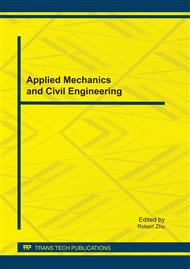[1]
M. Bevis, S. Businger, T.A. Herring, et a1, GPS meteorology : Remote sensing of atmospheric water vapor useing the global positioning system, J. Geophys Res .97(1992)15787-15801.
DOI: 10.1029/92jd01517
Google Scholar
[2]
G.P. Li, et al, Ground_based GPS Meteorology, Science press, Beijing, 2010.
Google Scholar
[3]
G.R. Xu, R. Wan, W.J. Li, et al, Improvement on the method for estimating precipitable water from ground-based GPS, J. Torrential Rain and Disasters .28(3)(2009)203-209.
Google Scholar
[4]
H.M Yang, P. He, B.X. Xu, et al, Analysis of water vapor characteristics of torrential rainfall in south China with GPS data, J. Meteorological Monthly, 28 (5)(2002)17-21.
Google Scholar
[5]
J. Guo, G.P. Li. Ground-based GPS in remote sensing of water vapor development and application, J.. Journal of geodesy and geodynamics, 27 (z1)(2007)35-42.
Google Scholar
[6]
J.G. Li, J.T. Mao, C.C. Li. The approach to Rremote sensing of water vapor based on GPS and linear regression Tm in eastern region of China, J. Acta Meteorologica Sinica ,57(3)(1999)283-292.
Google Scholar
[7]
M. Chen, S.Y. Fan, J.Q. Zhong, et al, An experimental study of assimilating the Global Position System-preeipitable water vapor observations into the rapid updated cycle system for theBeUing area, J.Acta Meteorologica Siniea, 68(4)(2010)450-463.
Google Scholar
[8]
P.X. Sheng, J.T. Mao, J.G. Li. et al, Atmosphere physics. Peking university press,Beijing, 2003.
Google Scholar
[9]
P. Xie, C.L. Zhang, Y.C. Wang, et al. Atmospheric water vapor experiment with the mixed single- and dual-frequency ground-based GPS-met network in Beijing ,J. Journal of applied meteorological science,17(z1)(2006)28-34.
Google Scholar
[10]
J. Saastamoinen. Contributions to the theory of atmospheric refraction, J. Bull Geod, 107(1973)13-34.
Google Scholar
[11]
X.W. Zhang. A relationship between precipitable water and surface vapor pressure, J. Meteorological Monthly, 30 (2)(2004)9-11.
Google Scholar
[12]
Y.C Xiang, Z.H. Chen, G.R. Xu, et al, A Comparsion and analysis of the results of three methods for the calculation of water vapor resources, J. .Meteorological Monthly, 35 (11)(2009)48-54.
Google Scholar
[13]
Y. Wang, B.Y. Yang, Y.P. Liu, et al, The study of the model about mean vapor pressure-weighted temperature of the atmosphere based on radiosonde , J. Science of surveying and mapping, 35(2)(2010)112-113.
Google Scholar


